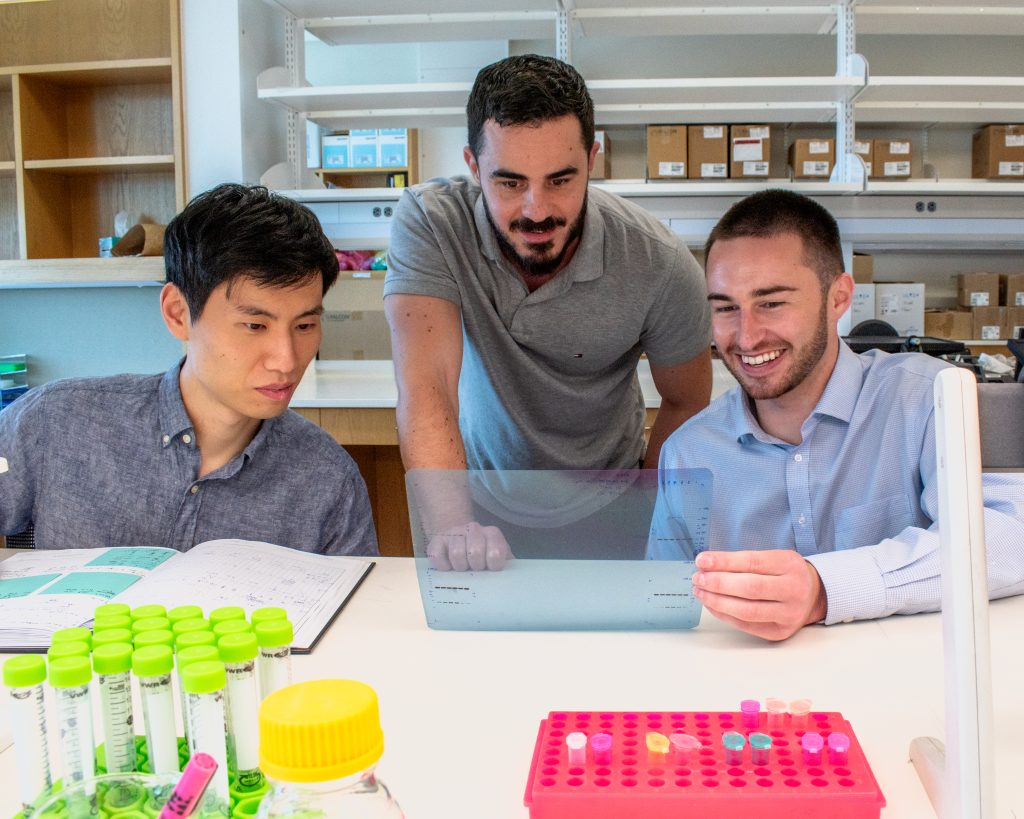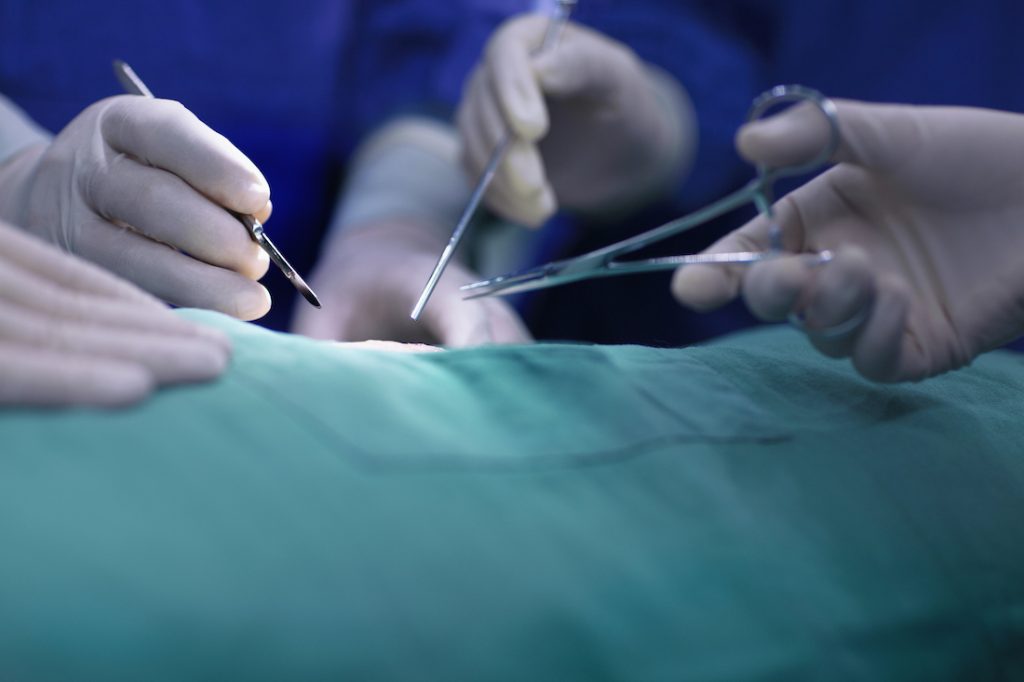CRI researchers find cancer cells use sulfated glycosaminoglycans to draw in lipoproteins, gain antioxidant protection from vitamin E
DALLAS – June 11, 2025 – Scientists have discovered tumors can tap a nontraditional pathway to acquire lipoproteins – molecules that transport fat in blood – which enriches cancer cells with an antioxidant shield to survive stress, according to new research from Children’s Medical Center Research Institute at UT Southwestern (CRI) published in Nature.

Researchers include (l-r) co-first author Lingjie Sang, Ph.D., postdoctoral fellow; senior author Javier Garcia-Bermudez, Ph.D., Assistant Professor in Children’s Medical Center Research Institute at UT Southwestern and Pediatrics; and co-first author Dylan Calhoon, B.S., graduate student researcher.
Javier Garcia-Bermudez, Ph.D., Assistant Professor in CRI and Pediatrics, along with first authors from his lab Dylan Calhoon, B.S., graduate student researcher, and Lingjie Sang, Ph.D., postdoctoral fellow, found cancer cells don’t rely on usual receptors to acquire lipoproteins. Instead, tumors use a different mechanism: special sugar-coated structures on the cell surface called sulfated glycosaminoglycans (GAGs).
Cancer cells need a steady supply of lipids to build their membranes, support vital functions, and survive stresses associated with disease progression. Cells can obtain lipids in two ways: making them from scratch or acquiring them from the blood via lipoproteins.
Lipoproteins transport the majority of lipids in blood, including a lipid called α-tocopherol – a form of vitamin E that cells cannot make on their own and can only be obtained from dietary intake. While α-tocopherol is an antioxidant that can nourish healthy tissues, Dr. Garcia-Bermudez and his team found this potent antioxidant shield is used by cancer cells to resist ferroptosis, a type of cell death triggered by toxic lipid by-product buildup.
CRI scientists showed that blocking GAG production in tumors reduced lipoprotein uptake and vitamin E levels, slowed tumor growth, and made cancer cells more vulnerable to elimination by ferroptosis.
“By targeting GAGs in cancer, we may have uncovered a way to strip tumors of their antioxidant shield provided by vitamin E, making them more vulnerable to therapies that trigger oxidative stress to kill cancer cells,” Dr. Garcia-Bermudez said. “GAGs also give tumors a unique way to access lipoproteins, as compared to how most healthy tissues acquire lipids. We also found this pathway can be exploited in human tumors, which we hope will lead to future cancer treatments with fewer side effects.”
To understand the impact in humans, Dr. Garcia-Bermudez collaborated with UTSW researchers studying clear cell renal cell carcinoma (ccRCC), the most common type of kidney cancer, as part of the Kidney Cancer Program (KCP) in the Harold C. Simmons Comprehensive Cancer Center at UT Southwestern.
By studying 20 patient kidney tumors, scientists confirmed that cancer cells had higher levels of GAGs and vitamin E compared to normal kidney tissue. When researchers then disrupted GAG production, patient-derived ccRCC tumors became less aggressive.
“These findings suggest that antioxidants are important for ccRCC to thrive and that interfering with their uptake may be beneficial and interrupt tumor progression. Furthermore, by identifying the uptake mechanism, Dr. Garcia-Bermudez provides a target for possible therapeutic intervention,” said James Brugarolas, M.D., Ph.D., founding Director of the KCP and Professor of Internal Medicine.
Future research in the Garcia-Bermudez Lab will focus on developing pharmacological approaches to precisely target GAGs and explore whether other lipids carried by lipoproteins – beyond vitamin E – help tumors spread or resist treatment.
Dr. Garcia-Bermudez is recipient of a 2024 National Institutes of Health (NIH) Director’s New Innovator Award and has been named an American Cancer Society (ACS) Research Scholar and a Cancer Prevention and Research Institute of Texas (CPRIT) Scholar.
Other study contributors are Vitaly Margulis, M.D., Professor of Urology; Ralph J. DeBerardinis, M.D., Ph.D., Professor and Director of the Eugene McDermott Center for Human Growth and Development, Professor in CRI and of Pediatrics, and Director of the CRI Genetic and Metabolic Disease Program; Ling Cai, Ph.D., Assistant Professor in the Peter O’Donnell Jr. School of Public Health and in CRI; and Ian Corbin, Ph.D., Associate Professor of the Advanced Imaging Research Center, Internal Medicine, and Radiology.
Drs. Brugarolas, Cai, and Garcia-Bermudez are members of the Cellular Networks in Cancer Research Program in the Simmons Cancer Center, which is co-directed by Dr. DeBerardinis.
Dr. Brugarolas holds the Sherry Wigley Crow Cancer Research Endowed Chair in Honor of Robert Lewis Kirby, M.D.
This study was funded by grants from the NIH, CPRIT, ACS, Howard Hughes Medical Institute (HHMI) Investigator Program, National Cancer Institute (NCI), a Human Frontiers Postdoctoral Fellowship, Natural Sciences and Engineering Council of Canada, Canada Foundation for Innovation, a Mark Foundation Emerging Leader Award, the NCI Kidney Specialized Programs of Research Excellence (SPORE), and a Cancer Center Support Grant.
About CRI
Children’s Medical Center Research Institute at UT Southwestern (CRI) is a joint venture of UT Southwestern Medical Center and Children’s Medical Center Dallas. CRI’s mission is to perform transformative biomedical research to better understand the biological basis of disease. Located in Dallas, Texas, CRI is home to interdisciplinary groups of scientists and physicians pursuing research at the interface of regenerative medicine, cancer biology, and metabolism.
X/Twitter | Blue Sky | LinkedIn | Instagram | YouTube | Facebook
About UT Southwestern Medical Center
UT Southwestern, one of the nation’s premier academic medical centers, integrates pioneering biomedical research with exceptional clinical care and education. The institution’s faculty members have received six Nobel Prizes and include 25 members of the National Academy of Sciences, 23 members of the National Academy of Medicine, and 14 Howard Hughes Medical Institute Investigators. The full-time faculty of more than 3,200 is responsible for groundbreaking medical advances and is committed to translating science-driven research quickly to new clinical treatments. UT Southwestern physicians provide care in more than 80 specialties to more than 140,000 hospitalized patients, more than 360,000 emergency room cases, and oversee nearly 5.1 million outpatient visits a year.


